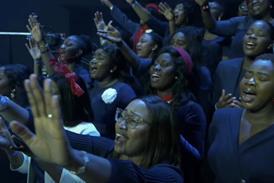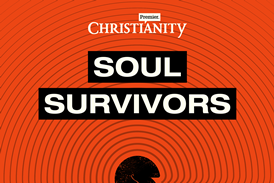Reports have emerged that crossbow killer, Clifford Kyle, accessed misogynistic content from Andrew Tate before raping and murdering his ex-girlfriend, and killing her sister and mother. These heartbreaking stories, along with others from inside the Church, demonstrate the need to ensure women’s equality and safety are prioritised, says Emma Hide, writing on the eve of International Women’s Day

International Women’s Day is a great opportunity for the Church to celebrate God’s transformative work in and through women. But as recent news stories show - from both within and outside the Church walls - there is still much work to be done to confront the sexism women face.
Take a moment and think about the women who serve diligently, lead and spearhead ministries in your church. Those who inspire with their strength, pray for others and support people in their faith journey. Why not send a woman you know a message of encouragement - or share this one - this weekend?
Sexism within and beyond the Church
Sexism is prejudice and discrimination based on gender. It includes daily interactions that oppress or belittle women, as well as systemic biases favouring men. It stems from conscious and unconscious beliefs about the nature and role of women in society.
Sexism surrounds us and intersects with race, disability, religion and socio-economic status. From the objectification of women in the media to financial and emotional neglect of single mothers, insults in the workplace and fewer development opportunities, sexism also fuels verbal, physical, sexual and spiritual abuse. In the UK, this is something that the government says 1 in 4 women have experienced.
And it can have very real - and dangerous - consequences, as the latest stories around Kyle Clifford, the so-called crossbow killer, have revealed. It emerged yesterday that Clifford’s internet searches in the days before he murdered his ex-girlfriend, her mum and sister included misogynist content from toxic influencer Andrew Tate.
Churches, which are meant to be safe havens, are sometimes no better. Research shows 82 per cent of women experience sexism in church, reflected in these true stories:
- A single mum, broken by unrepentant abuse, seeks refuge in church — only to be shamed for divorce.
- A schoolgirl sits frozen at home, dreading church, where boys whisper about the private photo her boyfriend betrayed her with.
- A woman feels alone and forgotten — her church family never acknowledges or discusses the issues she faces as a young, black woman.
- A friend stiffens as a man in church touches her inappropriately — she wonders if anyone saw, or would believe her story.
- A pastor’s wife, exhausted from work and childcare, is handed an apron before she can even sit down.
The church has got to step up – and I don’t just mean those in leadership, but the 3 million individuals who attend church regularly across the UK. Ignoring these issues means overlooking the experiences of half of Christ’s image-bearers — your friends, relatives, and sisters in Christ.
These issues are also having a tangible effect on church attendance. Durham University research into the abuse crisis in the Catholic Church reported that men and women are leaving church because of sexual abuse in all its forms.
Here are four ways you can champion women’s safety and worth in your church:
1. Cultivating a culture of acknowledgement, repentance and humility
Many struggle to believe sexism and abuse happens in their church, especially by respected leaders. Lack of awareness and denial can silence victims, who fear disbelief or inaction. The first step in addressing this is to recognise its presence and acknowledge it.
Church leaders must lead by example, humbly examining their own attitudes and recognising the unique or disproportionate barriers that women face. Listening to a range of women’s experiences, and engaging with resources such as The Disrupter Movement lays the foundation for practical action.
Both men and women must reflect on their thoughts, words and actions regarding the opposite sex. Matthew 5:27-28 warns that even lustful thoughts are sinful. Helpful questions include: Do I see the opposite sex as image-bearers of Christ or conquests/romantic interests? Do I truly believe, and act as if, women hold equal value? How does the use of porn shape my perception of women?
For true change, reflection must lead to repentance and action. This can be supported through sermons addressing abuse and sexism, safe spaces for women to share their experiences, open-dialogue groups and workshops on topics such as singleness, lust and marriage.
2. Implementing and communicating effective safeguarding
All churches in the UK are required to implement safeguarding policies to protect children, young people and vulnerable adults from abuse. Regular safeguarding training, policies and DBS checks are really important first steps. However, procedures and policies don’t guarantee protection or justice for women (and men and children). At times, institutions including The Church of England prioritise reputation over victims, as exemplified in horrific cases such as John Smyth.
Reporting abuse can be a traumatic, lengthy process, as described by Rev Martine Oborne. Some women are discouraged from speaking out, as was seen in a complaint against the Bishop of Liverpool, with Bishop Beverly Mason forced to turn to the media for justice. This is despite research from the Open University indicating 96 per cent of sexual abuse claims are valid.
Our internal and wider institutional cultures around sexism and abuse need continual work. Professor Alexis Jay’s proposals for independent scrutiny and safeguarding reforms in the CofE were not implemented in full, leading many to respond with anger and disappointment.
3. Creating a trauma-informed environment
People don’t leave their trauma at the door when entering church, especially if the church has contributed to their distress.
Trauma-informed practices can make church services more inclusive and supportive, by incorporating actions such as asking for permission before physical contact or prayer, avoiding triggering imagery and directing individuals towards support resources.
4. Actively teaching, celebrating and practising the biblical view on the value and worth of women
In a culture that often elevates men over women, the Church must actively affirm the God-given value of women. The Evangelical Alliance reports that 80 per cent of ministers in the UK are men, which means teaching naturally reflects male perspectives, emphasises male biblical and hero figures, and faith challenges. Majority male leadership teams can overlook women’s needs.
To address this, our theology needs honest and critical evaluation. Contextualised scripture can challenge cultural misconceptions about women’s worth and roles within the Church. Churches can highlight the ways Jesus uplifted and engaged with women and emphasise figures such as Sarah, Deborah, Esther, Ruth, Mary Magdalene, Mary mother of Jesus and Priscilla.
Women’s voices can be affirmed by sharing their testimonies. Women’s God-given talents, giftings and passions can be nurtured through including women in leadership and decision-making, mentoring, small groups and leadership training, recognising that sexism may deter them from naturally stepping forward.
What next?
Let’s not stand on the sidelines this International Women’s Day. Join the conversation:
- How will you celebrate the faith and testimonies of women in your church?
- What self-reflection is needed?
- How will you seek to better understand sexism in your church?
- What needs to change in your church?
As we reflect on these questions, let’s commit to creating a church culture where all women are not only valued but empowered to thrive. Together, we can make a lasting impact.





































No comments yet